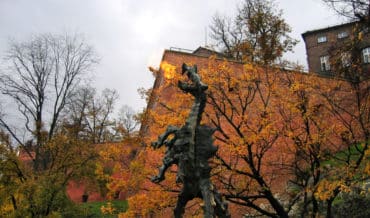These are basements that extend beyond the foundations of the house, and extend under the sidewalks along the town square houses. In the front walls of these cellars you can clearly see bricked up windows and stone portals. With the help of these cellars, today it is possible to reconstruct the appearance of the Gothic Market Square and answer an interesting question: Did Krakow have arcades or did it not? The excavations carried out in the Market Square showed that in the 14th and 15th centuries the level of cobblestones was much lower than today. At a depth of 2.2-2.8 meters, the existence of relics and monuments was found, allowing for the assumption that it was at this level that the cobblestones were located in the times of Casimir the Great. Even deeper, the plateau of the Market Square from the times of Władysław Łokietek was found, and a few dozen centimeters lower – the location leveling from 1257. The cellars are associated with the Gothic level. They could have been built in the Middle Ages, as evidenced by gothic brick, preserved window details, fragments of stairs and remains of entrance portals.
One of the most beautiful cellars is at number 17, in front of the Hetman’s tenement house.
Suggested
Suggested contents and articles.
Suggested Contents
Kazimierz, the current Krakow district, over the years was an independent village. In 1335 King Kazimierz Wielki gave it city rights, and the town was called after him. As the Kazimierz has been developing, there was a necessity to create a place for its government. As a result, in 1414,
- Knowledge Base, Museums
- February 9, 2021
Contents1 2 Location of the Main Square3 History of the Krakow Main Square3.1 Witness of Polish history4 Landmarks of the Main Square5 The Main Square today The Main Square in Krakow is a large, almost 430,000 ft2 square in the very heart of the historic Old Town. It is one of
- Attractions, Places to visit
- October 25, 2016
Contents1 Legend of Wawel Castle Dragon2 Dragon’s Den2.1 Wawel Castle Dragon Statue3 Plan your visit Legend of Wawel Castle Dragon The legend of the Wawel Castle Dragon is one of the most popular Polish tales. It is known thanks to Polish chronicler Wincenty Kadlubek who, in the late 12th century, had either written
- Attractions
- October 11, 2016
Comments
All comments.
Comments

